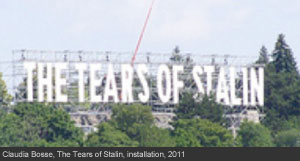
Abstract: During the Soviet occupation of Czechoslovakia between the years of 1968 and 1989, the regime sponsored and propagated the official communist narrative of the state. The communist narrative was characterized as a truthful narrative, or an accurate representation of the history of the Czech lands, but, in fact, this history was heavily manipulated by the regime. Although not always understood in this context, perception of truth is connected to a dynamic of power wherein the privileged side controls not only the present and the future but also the past. Contemporary Czech art continues to respond to historical conditions that no longer exist, including the Soviet occupation as well as the erasing, changing, and manipulating of history. While Czech art functions as an assertion of identity and power, Czech artists are also acutely aware of the connection between memory and history; they understand the danger of a society forgetting its past. In this way, Czech artists connect the disempowerment of the nation in the past to the current national identity. This paper will examine seven examples of post-revolutionary Czech art in order to demonstrate the ways that contemporary Czech art functions in public space as visual and spatial reclamations of Czech history, identity, and memory.